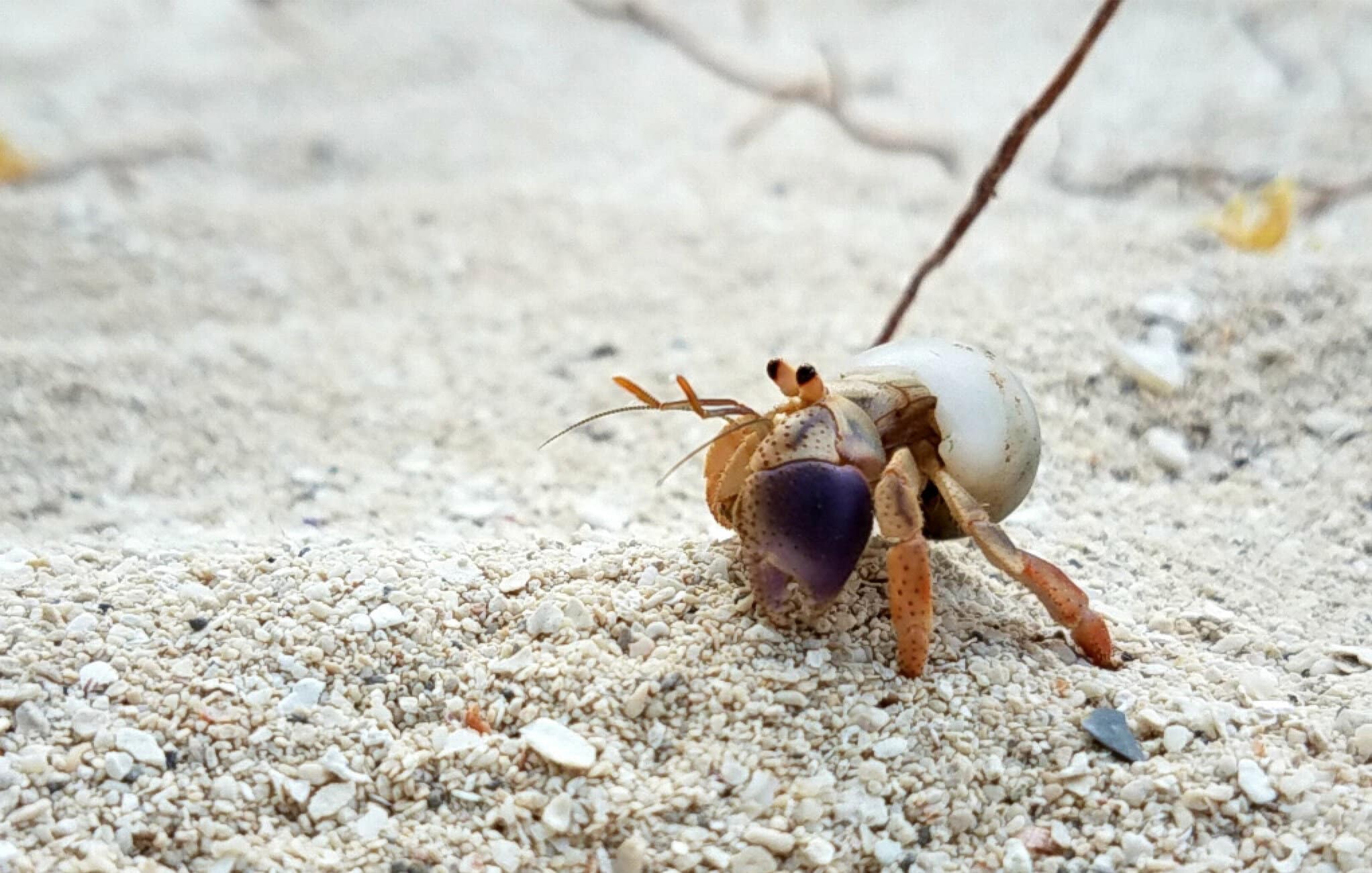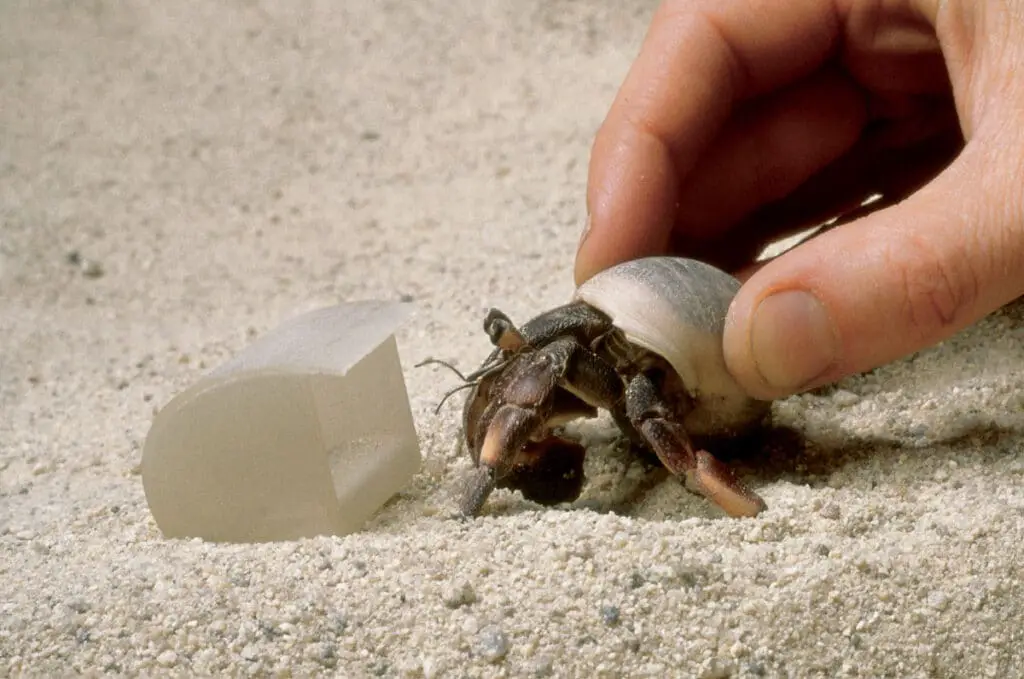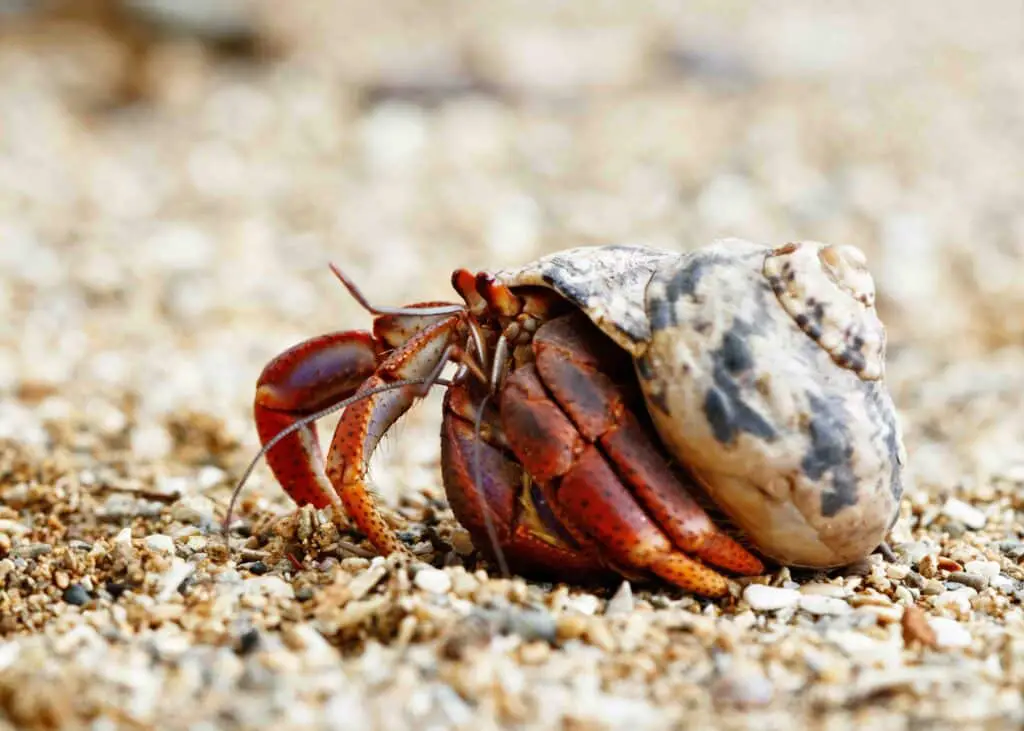Where Do Hermit Crab Shells Come From

Introduction
Where Do Hermit Crab Shells Come From: Hermit crabs, those fascinating crustaceans that inhabit seashores and coastal regions around the world, have a remarkable and often overlooked secret: their ever-changing homes. Unlike most creatures with shells, hermit crabs don’t grow their own protective coverings. Instead, they rely on a captivating, resourceful strategy of repurposing shells discarded by other marine organisms. This intriguing process prompts us to explore the question: Where do hermit crab shells come from?
To answer this question, we delve into the intricacies of hermit crab behavior, and ecology. Understanding the origins of their shells provides a window into the intricate relationship between these crabs and their environment. It is a story of survival, adaptation, and recycling that has been unfolding for millions of years.
In this exploration, we will journey from the sandy shores of tropical beaches to the depths of the ocean, discovering the diverse sources of hermit crab shells. From the intricate process of shell selection to the coevolutionary relationships between hermit crabs and the organisms that create these shells, we will uncover the remarkable mechanisms that allow hermit crabs to thrive in their ever-changing homes.
Join us on this captivating journey as we unravel the mystery of where hermit crab shells come from, shedding light on the ingenious ways these creatures have evolved to ensure their survival in the dynamic world of the coastal ecosystem.

What are hermit crab shells made from?
The shells that hermit crabs seek are made by marine gastropods that secrete calcium carbonate from their mantel—the organ that covers their soft bodies. The shell is built up in deposits until the calcium carbonate becomes a crystalline structure held together via thin membranes of organic material.
Hermit crab shells are not crafted by the crabs themselves; instead, they are sourced from various natural materials found in their coastal habitats. The primary constituents of these shells are the calcium carbonate remnants of deceased mollusks, such as snail shells and clam shells. When a hermit crab outgrows its current shell or requires a new one, it embarks on a quest for a suitable replacement.
During this search, hermit crabs evaluate potential shells based on size, shape, and the condition of the opening. Once a suitable shell is found, the hermit crab will abandon its old shell and swiftly transition into the new one. This intricate process allows hermit crabs to maintain their mobility and protect their soft bodies.
They prefer shells that provide the best fit and protection, which can sometimes lead to fierce competition among crabs for access to the most desirable shells. Hermit crab shells are a testament to nature’s recycling system, with each new occupant inheriting the legacy of the previous inhabitant. These shells are a critical component of hermit crab survival, offering both protection from predators and the elements, while also serving as an intriguing example of adaptation and resourcefulness in the animal kingdom.
How do hermit crabs get a new shell?
Unlike snails, hermit crabs do not produce their own. shell. Instead, they use an abandoned shell made by another. animal, such as a marine snail.
Hermit crabs employ a fascinating and strategic process to acquire a new shell when they outgrow their current one or need to replace a damaged or unsuitable shell. When a hermit crab identifies a potential shell, it begins a carefully orchestrated transition.
First, the hermit crab inspects the available shells, considering factors like size, shape, and the condition of the shell’s opening. If a suitable shell is found, the hermit crab will start the transfer process. This typically involves the following steps:
Shell Swap: The hermit crab vacates its old shell and enters the new one, ensuring a snug fit. This transition needs to be swift, as the crab’s soft abdomen is vulnerable outside of the protective shell.
Abandoning the Old Shell: Once securely inside the new shell, the hermit crab leaves its old shell behind. This discarded shell may then become a potential home for another hermit crab in need.
Shell Adjustments: After the switch, the hermit crab may spend some time adjusting to its new shell, fine-tuning its grip and mobility. It may also make additional modifications by sealing the shell’s opening with a mix of mucus and sand to provide added security.
This process is essential for hermit crabs, as their choice of shell directly impacts their survival and well-being. Their remarkable ability to navigate this transition underscores their adaptability and resourcefulness in utilizing the resources available in their coastal environments.
Are hermit crabs born with shells?
Hermit crabs are not born with shells of their own. Instead, they just find a suitably sized shell to protect their bodies.
Crabs, including hermit crabs, are not born with shells. Unlike some other animals like turtles that hatch from eggs with protective shells, crabs have a different life cycle.
Crabs start their lives as tiny larvae in the ocean. These larvae are quite different in appearance from adult crabs and do not have shells. As they grow and develop, they go through a series of molts, where they shed their exoskeleton (the hard outer shell) to accommodate their increasing size. During this molting process, they are temporarily soft and vulnerable until their new, larger exoskeleton hardens.
Hermit crabs, in particular, do not have a hard, permanent exoskeleton like other crabs. Instead, they seek out and utilize external shells from other marine organisms, primarily mollusks, to protect their soft bodies. Hermit crabs continue to molt and change shells throughout their lives, always on the lookout for more suitable homes as they grow.
Crabs, including hermit crabs, are not born with their own shells but rather acquire and change shells as they grow and develop through a series of molts. Their reliance on external shells is a fascinating adaptation that allows them to thrive in their coastal habitats.
Can hermit crabs live without a shell?
Without a shell, a hermit crab is more vulnerable to the outside environment; its exoskeleton will get too dry, and the crab will become lethargic. Crab owners can help their pets find new homes before their health declines.
Hermit crabs cannot survive without a shell. The shell is an integral part of their existence, providing them with vital protection against predators and harsh environmental elements. Unlike other crabs, hermit crabs have soft, vulnerable abdomens that lack the tough exoskeleton found in their cousins. This vulnerability makes finding and inhabiting shells an absolute necessity for their survival.
When a hermit crab outgrows its current shell, it must promptly seek out a larger one. This process is not just a matter of comfort; it’s a matter of life and death. Without a suitable shell, a hermit crab is exposed and defenseless. It becomes an easy target for predators like birds, fish, and larger crabs.
Without a shell, a hermit crab’s delicate abdomen is susceptible to desiccation, or drying out, which could be fatal. Their reliance on shells has shaped their behavior, creating a fascinating interplay between the crab and its environment. This dependence on the discarded homes of other creatures highlights the ingenious ways nature equips its inhabitants for survival. In essence, for a hermit crab, a shell is not just a dwelling; it’s a suit of armor that ensures its continued existence in the intricate tapestry of coastal ecosystems.
Why aren’t hermit crabs born with shells?
Hermit crabs have an odd housing situation. Rather than produce their own shells like other crustaceans, they must find an empty shell made by a completely different species, marine snails, in order to protect their delicate abdomen.
Hermit crabs enter the world without shells for a compelling evolutionary reason. Unlike other crabs with rigid exoskeletons, hermit crabs have a soft, pliable abdomen. This characteristic grants them flexibility, but it also leaves them vulnerable to predators and environmental stressors. To counter this vulnerability, hermit crabs have evolved a unique adaptation: they seek out and inhabit discarded shells of snails or other mollusks.
This reliance on external shells offers a distinct advantage. By appropriating these natural fortresses, hermit crabs gain a level of protection that their soft abdomens cannot provide. It’s akin to wearing a tailored suit of armor tailored, perfectly adapted to their size and shape.
As hermit crabs grow, they periodically outgrow their current shells, prompting them to embark on a search for a larger, more accommodating one. This process, known as “shell selection,” showcases their adaptability and resourcefulness. It’s a vital aspect of their survival strategy.
Hermit crabs have embraced a symbiotic relationship with shells, demonstrating the remarkable ways in which nature can inspire ingenious solutions to challenges. This dependency underscores the intricacies of adaptation and highlights the ingenious strategies that creatures employ to thrive in their habitats.
Are crabs born with shells?
Even this early in life, crabs have a hard outer shell (exoskeleton). In order to grow and change stages, the larva must molt, which means shed or cast off its shell. During molting, the exoskeleton splits, and the soft-bodied larva backs out of the hard shell.
Crabs start their lives as tiny larvae in the ocean. These larvae are quite different in appearance from adult crabs and do not have shells. As they grow and develop, they go through a series of molts, where they shed their exoskeleton (the hard outer shell) to accommodate their increasing size. During this molting process, they are temporarily soft and vulnerable until their new, larger exoskeleton hardens.
Hermit crabs, in particular, do not have a hard, permanent exoskeleton like other crabs. Instead, they seek out and utilize external shells from other marine organisms, primarily mollusks, to protect their soft bodies. Hermit crabs continue to molt and change shells throughout their lives, always on the lookout for more suitable homes as they grow.
Crabs, including hermit crabs, are not born with their own shells but rather acquire and change shells as they grow and develop through a series of molts. Their reliance on external shells is a fascinating adaptation that allows them to thrive in their coastal habitats.
What types of shells do hermit crabs use?
Hermit crabs are ingenious in their selection of shells, utilizing a variety of shells sourced from different marine organisms. The types of shells they use can vary based on availability and the specific needs of individual hermit crabs. Here are some common types of shells that hermit crabs often adopt:
- Mollusk Shells: These are the most commonly used shells by hermit crabs. Snail shells, particularly those of marine snails, are a favorite choice due to their spiral shape and smooth interiors. Other mollusk shells, such as those from clams and periwinkles, are also used.
- Spiral Shells: Hermit crabs prefer shells with a spiral shape because it provides them with a snug fit, offering protection for their soft bodies. Spiral shells are typically easier for hermit crabs to enter and exit.
- Gastropod Shells: These are shells from gastropods, a class of mollusks that includes snails and slugs. The conical shape and availability of various sizes make gastropod shells a popular option.
- Bivalve Shells: Shells from bivalve mollusks, such as clams and mussels, are less common but still used by some hermit crabs. These shells have a distinct two-part structure.
- Other Shells: In some cases, hermit crabs may use the shells of other hermit crabs, though this is less common. Additionally, they may adapt to using shells from other marine organisms like sea urchins or even discarded human-made objects, such as bottle caps or small containers, if no suitable natural shells are available.
The choice of shell is critical for hermit crabs, as it impacts their mobility, protection, and overall survival. Their ability to select, modify, and switch shells throughout their lives is a testament to their resourcefulness and adaptability in the dynamic coastal environments they inhabit.
Are there any concerns about the availability of shells for hermit crabs?
There are indeed concerns about the availability of shells for hermit crabs, a crucial aspect of their well-being. Hermit crabs rely on empty shells to protect their soft, vulnerable abdomens, and as they grow, they need to find larger shells to accommodate their increasing size. However, a variety of factors have raised concerns about the availability of suitable shells for these unique crustaceans.
One major issue is the depletion of natural shell sources due to habitat destruction and pollution, which limits the number of shells available for hermit crabs in the wild. Additionally, the souvenir shell trade in some coastal areas has further reduced the availability of suitable shells for these creatures.
In captivity, pet owners often provide artificial shells or shells collected from the beach, but these may not always mimic the ideal conditions of natural shells. This can lead to hermit crabs experiencing stress and discomfort, impacting their overall health and longevity.
Conservation efforts and responsible collecting practices are essential to ensure that hermit crabs have access to the shells they need to thrive. By addressing these concerns, we can help protect these fascinating creatures and ensure their continued survival in both natural and captive environments.

Conclusion
The quest to uncover the origins of hermit crab shells has taken us on a fascinating journey through the intricate world of these remarkable crustaceans. As we conclude our exploration, we find ourselves with a newfound appreciation for the ingenuity of nature and the adaptability of hermit crabs.
Hermit crabs have mastered the art of recycling, repurposing the abandoned shells of other marine creatures to provide them with a protective home. This strategy not only showcases their resourcefulness but also highlights the interconnectedness of life in the coastal ecosystem.
Crabs journey has revealed that hermit crab shells come from a variety of sources, from the shells of deceased mollusks to the abandoned homes of other hermit crabs. The selection process is a critical aspect of their survival, as they must find a shell that not only fits but also offers protection and mobility.
In the grand tapestry of life on our planet, hermit crabs are but one example of the many ingenious solutions that species have developed to thrive in their respective niches. Their story reminds us of the beauty and complexity of the natural world, where every organism, no matter how small, plays a vital role.



